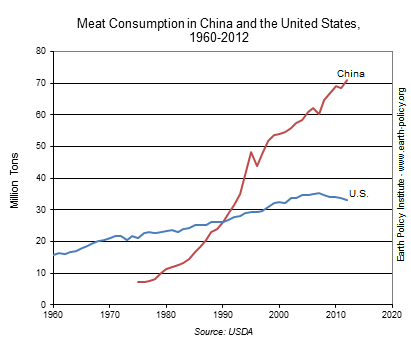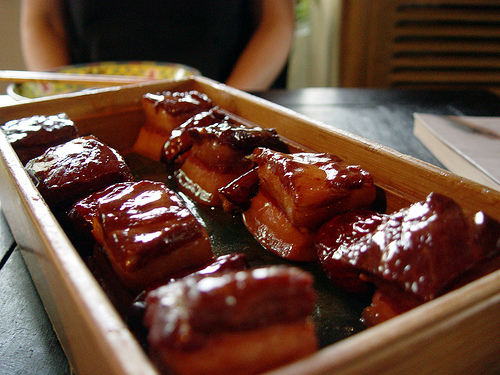If meat eating is a race, China is so far ahead of us we can’t even see what color shorts it’s wearing. Americans still eat about twice as much of the stuff on a per-person basis, but, well, China has a lot more people.
If you like geeking out about who eats what where and how it impacts the environment, you might enjoy spending some time with this very data-rich post about the recent doubling of China’s meat consumption from the Earth Policy Institute (EPI). But, for those who want a cheat sheet, I’ve collected what I think are some of the most memorable bits below.
First, take a look at this very telling chart, which shows plain and clear how fast things have been changing:

Where as Chinese diet has long centered around grains and vegetables (meat and eggs were more like a garnish), it’s clear that pork, chicken, and fish have been taking up a much more substantial place in the national diet.
You’ll notice I didn’t say beef. That’s because beef is still somewhat of a delicacy there (they eat only 6 million tons a year, compared to our 11 million). Not only is land less available for grazing, writes EPI’s Janet Larsen, but:
Cattle in feedlots gobble up about 7 pounds of grain for each pound of weight gain. For pigs, the feeding ratio is 3 to 1, and for chickens it is 2 to 1. With one fifth of the world’s population and limited land and water supplies, China has had to rely heavily on the more-efficient forms of animal protein.

Pork belly in box, served at a restaurant in Beijing. (Photo by Omefrans.)
Pork, on the other hand, has been the national object of affection for a while now, and accounts for almost three-fourths of the nation’s meat consumption (they eat a whopping 52 million tons a year to our 8 million). And, to accommodate all the pork dumplings and sweet pork belly, the mode of production in China has also changed hugely. Larsen adds:
Traditionally China’s pigs were raised in small numbers by households feeding them crop waste and table scraps. As many American kitchens today have a garbage disposal, Chinese kitchens had a pig. Indeed, the written Mandarin Chinese character for “home” depicts a pig under a roof, signifying the animal’s longtime domestic importance. But now the ramped-up demands of a richer and increasingly urbanized society have taken more pigs out of the backyard and into specialized livestock operations [read CAFOs], where they are fed grain and soybeans.
China also farms a lot of seafood. A full 37 million tons of it, or 60 percent of the world total. Many of these fish are herbivores and also rely on grains. Which brings us to what might be the most surprising finding from the EPI article: China now grows more corn that rice. And — you’ve probably guessed this by now — most of it goes to feed animals!
In 2011, they grew 192 million tons of corn for animal feed, while the 140 million tons of rice and 118 million tons of wheat they grew all went directly to foods eaten by people — like noodles, buns, dumplings, etc. They also import an astounding quantity of soybeans from the U.S. and Brazil to feed animals. In 2011, China harvested the most grain of any country in history and around one-third of that harvest is going to feed animals to meet their demand for meat, milk, eggs, and farmed fish. And environmental impact — like today’s global cuisine — knows no borders. Larsen writes:
China’s incredible appetite for meat has altered the landscape of the western hemisphere, where the land planted in soybeans now exceeds that in either wheat or corn. Rainforest and savanna have been cleared to make way for a vast soybean monoculture.
Indeed, that’s what happens when you take our Western food system and blow it up really large. And I don’t know about you, but the next time someone tries to tell me they think food and farming isn’t an important global issue, I’ll know just where to send them.



